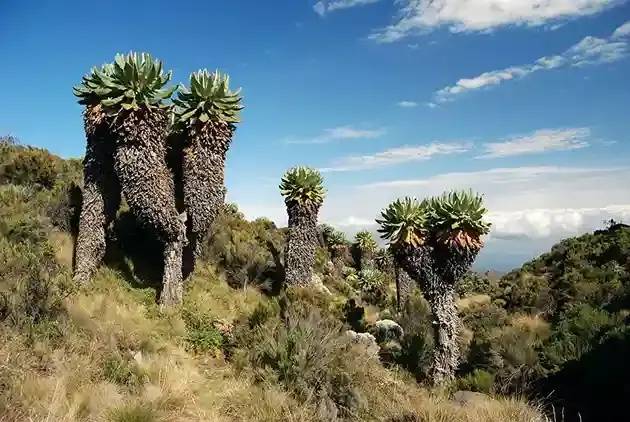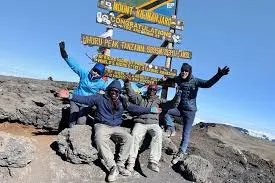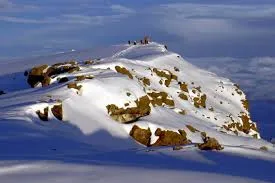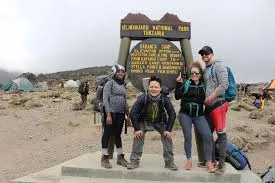Lemosho Route Overview: Scenic Kilimanjaro Adventure
The Lemosho Route provides a beautiful and quieter way to climb Kilimanjaro. It takes you through different ecosystems, from lush rainforests to alpine deserts. Hikers gain altitude gradually, which helps with acclimatization and boosts the chances of reaching the summit. Along the journey, you can enjoy sweeping views, see unique wildlife, and appreciate the peaceful beauty of the mountain’s western slopes. Below is an overview of the Lemosho Route. It highlights the key experiences and essentials for your 6 to 9-day trek with Capable Africa Tours.
Plan Your Lemosho Trek Now
Why Choose the Lemosho Route for Kilimanjaro?
The Lemosho Route provides a great mix of beautiful scenery, higher chances of reaching the summit, and a quieter trekking experience compared to other routes. It includes lush rainforests, wide moorlands, and stunning views that help climbers adapt slowly. With longer trekking days, there is more time for your body to get used to the altitude, which boosts your chances of reaching the summit safely and comfortably. Below is a detailed overview of why the Lemosho Route is a fantastic choice for your Kilimanjaro adventure with Capable Africa Tours.
Lemosho Route Highlights
- Scenic Diversity: Traverse lush rainforests, volcanic plateaus, and glaciers with views of the Shira Cathedral and Uhuru Peak.
- High Success Rate: Gradual ascent over 7–8 days boosts acclimatization, achieving 85–90% summit success.
- Low Crowds: Less congested than Machame or Marangu routes, ideal for a peaceful trek.
- Wildlife Encounters: Spot colobus monkeys, blue monkeys, and vibrant birdlife in the rainforest zone.
- Flexible Itineraries: Choose 7 or 8-day options with Capable Africa Tours for optimal pacing.
Difficulty and Preparation for the Lemosho Route
The Lemosho Route is considered one of the more scenic and moderately challenging Kilimanjaro paths, with a gradual ascent that allows better acclimatization. Prepare by building cardiovascular endurance and leg strength through hiking, stair climbing, or long walks in varied terrain. Practice carrying a loaded daypack to simulate trek conditions, and ensure you are comfortable with multi-day hikes at higher altitudes. Mental preparation is equally important pace yourself, stay hydrated, and listen to your body.
Key Preparation Tips
- Cardio Training: Run, cycle, or swim 4–5 times weekly for 45–60 minutes to build endurance.
- Strength Workouts: Focus on squats, lunges, and core exercises to handle steep terrain.
- Practice Hikes: Train with a 5–7 kg backpack on hilly trails to mimic trek conditions.
- Altitude Prep: If possible, hike at elevations above 2,500 m or use altitude simulation gear.
- Gear Testing: Break in boots and test layers on long hikes to avoid blisters and discomfort.
Lemosho Route Stats
| Metric | Value |
|---|---|
| Total Distance | 70 km / 43.5 mi |
| Duration | 7–8 days |
| Elevation Gain | 3,795 m / 12,451 ft |
| Summit Success Rate | 85–90% (8-day itinerary) |
| Average Daily Hiking Time | 6–8 hours |
| Climate Zones | 5 (Rainforest, Heath, Moorland, Alpine Desert, Arctic) |
Experience the Lemosho Route in Action
Watch this video to see why the Lemosho Route with Capable Africa Tours is Kilimanjaro’s most scenic adventure, featuring lush forests, dramatic plateaus, and the iconic summit climb.
Essential Gear and Packing for Lemosho
For your Lemosho route climb, focus on bringing essential gear that balances comfort, safety, and weight. Layer moisture-wicking base layers, insulating mid-layers, and waterproof/windproof outer layers. Choose a lightweight, durable duffel bag for main gear and a daypack for daily essentials. Don’t forget trekking poles, a warm sleeping bag, headlamp, and sun protection. Organize efficiently with compression sacks and pack strategically to maximize space. Capable Africa Tours provides porters to carry up to 15 kg of your gear, leaving you with a 5–7 kg daypack. Focus on layering, waterproof gear, and lightweight essentials to stay warm, dry, and comfortable.
Packing Checklist
- Base Layers (3–4 sets): Merino wool or synthetic (200g) for moisture-wicking (40–80°F).
- Mid-Layers (2): Fleece or softshell jackets (300–400g) for insulation (20–60°F).
- Outer Layers (1–2): Gore-Tex jacket and pants for rain and wind (0–40°F).
- Thermal Gear (1 set): 800-fill down jacket and thermal underwear for summit night (0–20°F).
- Footwear: Waterproof hiking boots (mid/high-ankle), 3–4 pairs merino wool socks, and gaiters.
- Accessories: Wide-brimmed hat, UV400 sunglasses, SPF 50+ sunscreen, neck gaiter, gloves (inner and waterproof outer).
- Other Essentials: 30–40L daypack, 3L water bladder, trekking poles, headlamp, and sleeping bag (rated to -15°C).
Gear Rental with Capable Africa Tours
Save luggage space by renting high-quality gear like sleeping bags, down jackets, and trekking poles from Capable Africa Tours. Our rentals are sanitized and well-maintained, ensuring comfort without the hassle of extra baggage.
Best Time to Climb the Lemosho Route
The best time to climb the Lemosho Route is during the dry seasons: late June to October and late December to February. These months offer clearer skies, less rain, and a higher chance of reaching the summit successfully. Capable Africa Tours recommends the dry seasons January to March and June to October—for clear skies and stable conditions. Avoid April–May and November due to heavy rains and muddy trails.
Seasonal Breakdown
| Season | Months | Weather | Pros | Cons |
|---|---|---|---|---|
| Dry (Peak) | Jan–Mar, Jun–Oct | Clear skies, 0–80°F | Best views, stable trails | Higher crowds |
| Wet | Apr–May, Nov | Heavy rain, muddy | Fewer trekkers | Poor visibility, slippery trails |
| Shoulder | Dec, early Jun | Mixed, light rain | Moderate crowds, decent views | Unpredictable weather |
Lemosho Route Costs and Inclusions
Climbing the Lemosho Route with Capable Africa Tours costs $2,500–$3,500 for a group trek, depending on group size and itinerary (7 or 8 days). Our all-inclusive packages cover park fees, experienced guides, porters, meals, camping gear, and transfers. Contact us for a tailored quote.
What’s Included
- Kilimanjaro National Park fees ($800–$1,000 per person)
- Professional guides and porters (1 guide per 2 trekkers, 3–4 porters per trekker)
- All meals (fresh, high-calorie for energy) and purified water
- High-quality camping gear (tents, sleeping pads)
- Round-trip transfers from Kilimanjaro International Airport
- Safety equipment (oxygen tanks, first aid kits)
Additional Costs to Consider
- International flights to Tanzania ($800–$1,500)
- Travel insurance (covering high-altitude trekking)
- Personal gear (boots, clothing, backpack)
- Tips for guides and porters ($200–$300 recommended)
- Optional pre/post-trek lodging in Moshi or Arusha
Ready to Climb Kilimanjaro’s Lemosho Route?
Join Capable Africa Tours for an unforgettable Lemosho Route adventure. Our expert guides, eco-friendly practices, and 90% summit success rate ensure a safe, scenic climb to Uhuru Peak. Book now to secure your spot!
- 90% summit success rate with 8-day itinerary
- Eco-conscious treks supporting local communities
- Gear rentals for sleeping bags, jackets, and more
- Customizable itineraries for all fitness levels
- All-inclusive packages with meals and transfers
Limited spots available for Lemosho Route treks — book now to conquer Kilimanjaro!
Plan Your Trek Now


